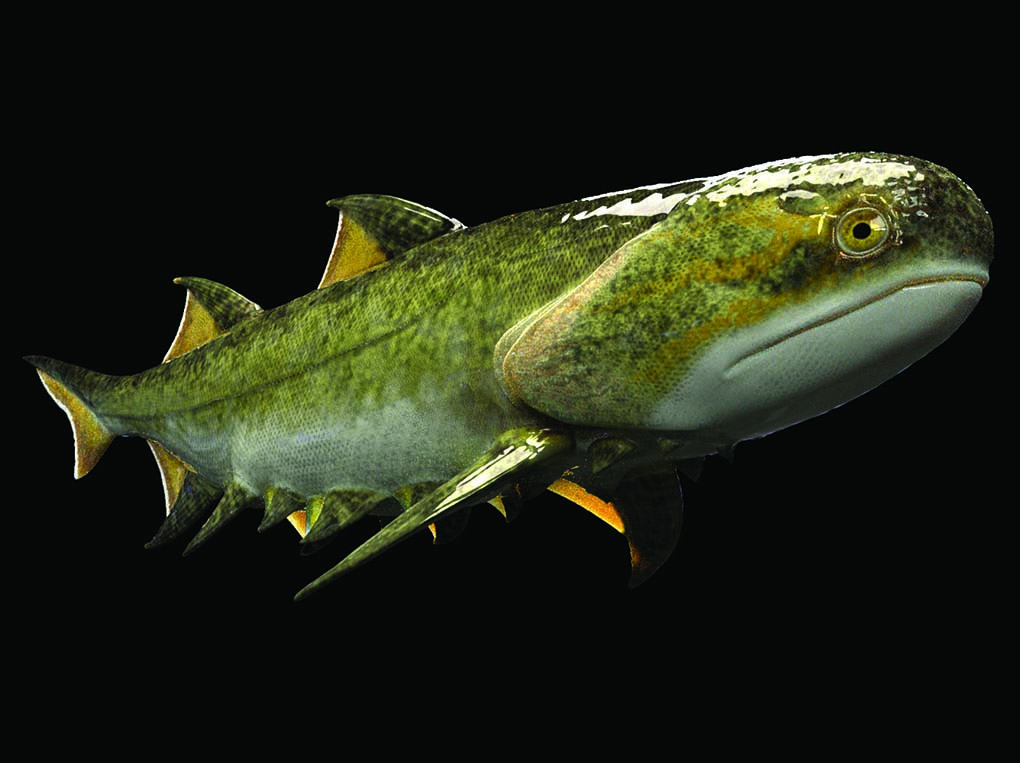
Fanjingshania renovata, artist’s reconstruction of the earliest-known jawed fish, an acanthocodian similar to primitive “spiny sharks.” These ocean-going predators pre-date the appearance of corals—and humans—by hundreds of million years. Credit: Heming Zhang.
Living sharks are often portrayed as the apex predators of the marine realm and living examples of primitive fishes that have been swimming in Earth’s seas from primordial times. Paleontologists have been able to identify fossils of their extinct ancestors that date back hundreds of millions of years to a time known as the Palaeozoic period. These early “sharks,” known as acanthodians, bristled with spines.
A recent discovery of a new species of acanthodian from China surprised scientists with its antiquity. The find predates by about 15 million years the earliest acanthodian body fossils and is the oldest undisputed jawed fish.
Reconstructed from thousands of tiny skeletal fragments, Fanjingshania, named after the famous UNESCO World Heritage Site Mount Fanjing (Fanjingshan), is a bizarre fish with an external bony “armor” and multiple pairs of fin spines that set it apart from living jawed fish, cartilaginous sharks and rays, and bony ray- and lobe-finned fish.
Examination of Fanjingshania by a team of researchers from the Chinese Academy of Sciences, Qujing Normal University, and the University of Birmingham revealed that the species is anatomically close to groups of extinct spiny “sharks” collectively known as acanthodians, according to new findings recently published in Nature. Unlike modern sharks, acanthodians have skin ossifications of the shoulder region, effectively a sort of bony “armor” around their paired fins, typical in primitive jawed fish.
The fossil remains of Fanjingshania were recovered from bone bed samples of the Rongxi Formation at a site in Shiqian County of Guizhou Province, South China. These findings present tangible evidence of a diversification of major vertebrate groups tens of millions of years before the beginning of the so called “Age of Fishes” some 420 million years ago in the Devonian Period. The earliest-known Scleractinian (stony) corals first appear in the fossil record in the Middle Triassic Period (240 million years ago).
“This is the oldest jawed fish with known anatomy,” said Prof. Zhu Min from the Institute of Vertebrate Paleontology and Paleoanthropology (IVPP) of the Chinese Academy of Sciences. “The new data allowed us to place Fanjingshania in the phylogenetic tree of early vertebrates and gain much needed information about the evolutionary steps leading to the origin of important vertebrate adaptations such as jaws, sensory systems, and paired appendages.”

Dr. Ivan Sansom of Birmingham University in England is a paleobiologist studying the earliest fishes on Earth, often working with fossilized remains in now-arid locales. Credit: University of Birmingham
From the outset, it was clear to the scientists that Fanjingshania’s shoulder girdle, with its array of fin spines, is key to pinpointing the new species’ position in the evolutionary tree of early vertebrates. They found that a group of acanthodians, known as climatiids, possess the full complement of shoulder spines recognized in Fanjingshania. What is more, in contrast to normal dermal plate development, the pectoral ossifications of Fanjingshania and the climatiids are fused to modified trunk scales. This is seen as a specialization from the primitive condition of jawed vertebrates where the bony plates grow from a single ossification center.
Unexpectedly, the fossil bones of Fanjingshania show evidence of extensive resorption and remodeling that are typically associated with skeletal development in bony fish, including humans.
“This level of hard tissue modification is unprecedented in chondrichthyans, a group that includes modern cartilaginous fish and their extinct ancestors,” said lead author Dr. Plamen Andreev, a researcher at Qujing Normal University. “It speaks about greater than currently understood developmental plasticity of the mineralized skeleton at the onset of jawed fish diversification.”
“The new discovery puts into question existing models of vertebrate evolution by significantly condensing the timeframe for the emergence of jawed fish from their closest jawless ancestors. This will have profound impact on how we assess evolutionary rates in early vertebrates and the relationship between morphological and molecular change in these groups,” said Dr. Ivan J. Sansom from the University of Birmingham.
—Li Yuan, from materials released by the Chinese Academy of Sciences
Reference
Andreev, P.S., Sansom, I.J., Li, Q. et al. Spiny chondrichthyan from the lower Silurian of South China. Nature 609, 969–974 (2022). https://doi.org/10.1038/s41586-022-05




